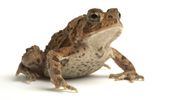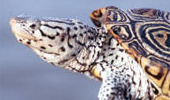“Toads prefer to bound, not hop,” says Science News Wild Things writer Sarah Zielinski about research by Dr. Stephen Reilly, Professor of Biological Science at Ohio University.
If I were to write a children’s book, it might start like this: Hop, hop, hop, went the frog. Bound, bound, bound, goes the toad.
Toads also hop, but they’re more likely to bound like a squirrel, says a new study published January 29 in Functional Ecology. That bounding method of locomotion gives toads a leg up when it comes to dispersal, helping species like cane toads become the invading menaces we know today.
Stephen Reilly of Ohio University in Athens and colleagues studied the hopping behavior of three species of bufonid toads: American toads (Anaxyrus americanus), Fowler’s toads (A. fowleri) and cane toads (Rhinella marina). Cane toads are a particular concern because they are an incredibly destructive invasive species in Australia.
Read the entire Wild Things story.
Reilly Article in Functional Ecology
Reilly’s research on “Conquering the world in leaps and bounds: hopping locomotion in toads is actually bounding” was published Jan. 29 in Functional Ecology. His co-authors are Stephane J. Montuelle and Andre Schmidt of Ohio University’s Heritage College of Medicine, Emily Naylor of OHIO’s Biological Sciences Department, Michael E. Jorgensen of the University of Missouri, Lewis G. Halsey of the University or Roehampton, and Richard L. Essner Jr. of Southern Illinois University.
Abstract Summary
- While most frogs maximize jump distance as an escape behavior, toads have traded jump distance for endurance with a strategy of hopping repeatedly. This strategy has enabled toads to expand across the continents as one of the most diverse groups of anurans. Multiple studies have revealed physiological endurance adaptations for sustained hopping in toads, however, the kinematics of their sequential hopping behavior, per se, has not been studied.
- We compared kinematics and forces of single hops and multiple hopping sequences and quantified field performance of hopping behaviors in free ranging toads of three species and discovered a novel aspect of locomotion adaptation that adds another facet to their exceptional terrestrial locomotor abilities.
- We found that bouts of repeated hopping are actually a series of bounding strides where toads rotate on their hands and then land on their extended their feet and jump again without stopping. In addition, free-ranging toads appear to use bounding locomotion more frequently than single hops. Bounding in toads has the advantage of maintaining velocity and producing longer jump distances. In comparison to single hops, cyclic bounding steps reduce energy expenditure and appear to provide limb loading dynamics better suited for potential cycling of elastic energy from stride to stride than would be possible with repeated single hops.
- This is the first case of the common use of a bounding gait outside of mammals. Bounding adds a key terrestrial locomotor trait to the toad’s phenotype that may help explain their history of global expansion and the challenges to modern faunas as introduced toads rapidly invade new ecosystems today.





















Comments